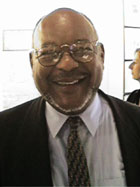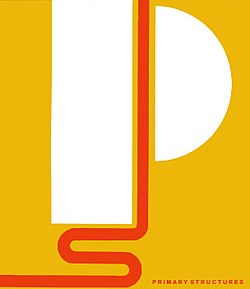 |
| Kynaston McShine at the Art Show, the 7th Reg. Armory 1997 (artnet.com) |
 |
| Kynaston (1963, by Alex Katz) |
McShine has spent nearly his career at MoMa, which he joined in 1959 as a member of its Department of Circulating Exhibitions. In 1965, however, he joined the Jewish Museum in New York as a curator, going on to serve as its acting director from 1967-68. McShine returned to MoMa in 1968 as associate curator, was named curator in 1971, and in 1980, he became senior curator in MoMa's Department of Painting and Sculpture, a position he served in until 2001, when he became Acting Chief Curator of the department. In 2003, he was named Chief Curator at Large.
At the Jewish Museum, he organized several important shows, including Primary Structures: Younger British and American Sculpture (1966) and Yves Klein (1967). At MoMa McShine has curated a slew of that institution's most important and high-profile shows of the last 40 years, including Information (1970); Ways of Looking (1971); Marcel Duchamp (1973, with Ann d'Harnoncourt, who later became the director and CEO of the Philadelphia Museum of Art); The Natural Paradise: Painting in America, 1800-1950 (1976, an exhibit that coincided with the Bicentennial celebrations across the country); Joseph Cornell (1980); Berlinart 1961-1987 (1987); Andy Warhol: A Retrospective (1989); The Museum as Muse, The Artists Reflect (1999), Edvard Munch: Beyond the Scream (2006), and Richard Serra at MoMa (2007, with Lynne Cooke, of the Dia Foundation for the Arts). In 1971, McShine initiated MoMa's Projects series, which focused on works by younger experimental artists.
 |
| Clara Weyergraf-Serra and Kynaston McShine (DPC/NYSD.com) |
 McShine's exhibits for MoMa's Department of Circulating Exhibits include Josef Albers: Homage to the Square (1964); American Collages (1965); Four American Sculptors (1965); New Media: New Methods (1969); and Color As Language (1975). In 1988, he coordinated the New York exhibition of Anselm Kiefer, a show jointly organized by MoMa, the Art Institute of Chicago and Philadelphia Museum of Art. As far as I can tell, McShine has never organized a show devoted primarily to black, Caribbean or African-American arts or artists of at all, though a number have appeared in the broader surveys he has curated (I am thinking of Fred Wilson's work, for example, in The Museum as Muse, for example), and artists of color have numbered among the participants in the Projects series. [UPDATE: McShine did curate solo shows featuring the work of Sam Gilliam and Rafael Ferrer; perhaps there were other solo shows featuring artists of color as well.)
McShine's exhibits for MoMa's Department of Circulating Exhibits include Josef Albers: Homage to the Square (1964); American Collages (1965); Four American Sculptors (1965); New Media: New Methods (1969); and Color As Language (1975). In 1988, he coordinated the New York exhibition of Anselm Kiefer, a show jointly organized by MoMa, the Art Institute of Chicago and Philadelphia Museum of Art. As far as I can tell, McShine has never organized a show devoted primarily to black, Caribbean or African-American arts or artists of at all, though a number have appeared in the broader surveys he has curated (I am thinking of Fred Wilson's work, for example, in The Museum as Muse, for example), and artists of color have numbered among the participants in the Projects series. [UPDATE: McShine did curate solo shows featuring the work of Sam Gilliam and Rafael Ferrer; perhaps there were other solo shows featuring artists of color as well.)In one of the pieces I link to above, an article in The Economist, the writer describes McShine as "discreet." I would love someday (he's 72 [76?], so I suppose I should get on it) to interview him, and discuss his background, life and career, his deep interests in the art of his time and his central, publicly un(der)acknowledged role in bringing that art to critical and public consciousness. Perhaps an interview of this sort already exists; I just haven't seen it. Then, where to publish it?
Also: there's this kynastonmcshine, in the UK. I wonder if he knows about and has given his blessing to them?











If you could a secure an Interview with McShine, power to you. He has declined to be interviewed by both Hans Ulrich Obrist and Carolee Thea for each's respective volumes of interviews with influential curators. To my knowledge he has no published interviews, and I can't even find any footage of him speaking on panels or anything of the like. perhaps MoMA has some stuff in their archives?
ReplyDeleteThanks so much for posting this summary of McShine's career, its a really good entry point into his work!
-Lisa Bryan-Brown
This is the most useful scope of information on him that I have found on the internet. Thank you!
ReplyDeleteMarie Gasper-Hulvat
Hello there,
ReplyDeleteI am writing my dissertation on McShine and have a few questions about your sources. As you note in your post, published biographical details on McShine are few and far between.
How did you find out that he went to the University of Michigan?
I'm also finding a lot of conflicting information about his "acting director" position at the Jewish Museum. Solomon resigned in early 1965 and Hans Van Weeren-Grieck was brought on board to fill the director position until Sam Hunter took over in September 1965. Hunter resigned in 1967; Karl Katz took over in 1968 (see Karl Katz's recent book, The Exhibitionist: Living Museums, Loving Museums).
Looking forward to hearing from you!
-S.